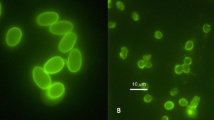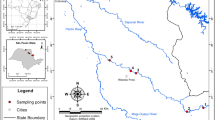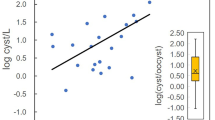Abstract
In this study, the Quantitative Microbial Risk Assessment (QMRA) methodology was applied to estimate the annual risk of Giardia and Cryptosporidium infection associated with a water treatment plant in southern Brazil. The efficiency of the treatment plant in removing protozoa and the effectiveness of the Brazilian legislation on microbiological protection were evaluated, emphasizing the relevance of implementing the QMRA in this context. Two distinct approaches were employed to estimate the mechanical removal of protozoa: The definitions provided by the United States Environmental Protection Agency (USEPA), and the model proposed by Neminski and Ongerth. Although the raw water collected had a higher concentration of Giardia cysts than Cryptosporidium oocysts, the estimated values for the annual risk of infection were significantly higher for Cryptosporidium than for Giardia. From a general perspective, the risk values of protozoa infection were either below or very near the limit set by the World Health Organization (WHO). In contrast, all the risk values of Cryptosporidium infection exceeded the threshold established by the USEPA. Ultimately, it was concluded that the implementation of the QMRA methodology should be considered by the Brazilian authorities, as the requirements and guidelines provided by the Brazilian legislation proved to be insufficient to guarantee the microbiological safety of drinking water. In this context, the QMRA application can effectively contribute to the prevention and investigation of outbreaks of waterborne disease.




Similar content being viewed by others
Data availability
The datasets generated during and/or analyzed during the current study are available from the corresponding author on reasonable request.
References
Bataiero, M. O., Araujo, R. S., Nardocci, A. C., Matté, M. H., Sato, M. I. Z., Laureto, M. S., & Razzolini, M. T. P. (2019). Quantification of Giardia and Cryptosporidium in surface water: A risk assessment and molecular characterization. Water Supply, 19(6), 1823–1830.
Betancourt, W. Q., & Rose, J. B. (2004). Drinking water treatment processes for removal of Cryptosporidium and Giardia. Veterinary Parasitologsy, 126, 219–234.
Blume, K. K., Macedo, J. C., Meneguzzi, A., Silva, L. B., Quevedo, D. M., & Rodrigues, M. A. S. (2010). Water quality assessment of the Sinos River Southern Brazil Blume. Brazilian Journal of Biology, 70(4), 1185–1193.
Brasil, M. S. (2017). Portaria de consolidação nº 5, de 28 de setembro de 2017. Consolidação das normas sobre as ações e os serviços de saúde do Sistema Único de Saúde. Anexo XX. Do controle e da vigilância da qualidade da água para consumo humano e seu padrão de potabilidade. Ministério da Saúde. Diário Oficial da União. https://www.gov.br/saude/pt-br/composicao/sectics/daf/pnpmf/orientacao-ao-prescritor/Publicacoes/portaria-de-consolidacao-no-5-de-28-de-setembro-de-2017.pdf/view
Brasil, M. S. (2021). Portaria GM/MS nº 888. Altera o Anexo XX da Portaria de Consolidação nº 5/GM/MS, de 28 de setembro de 2017, para dispor sobre os procedimentos de controle e de vigilância da qualidade da água para consumo humano e seu padrão de potabilidade. Ministério da Saúde. Diário Oficial da União. https://bvsms.saude.gov.br/bvs/saudelegis/gm/2021/prt0888_07_05_2021.html
Conners, E. E., Miller, A. D., Balachandran, N., Robinson, B. M., & Benedict, K. M. (2021). Giardiasis outbreaks-United States, 2012–2017. Morbidity and Mortality Weekly Report, 70(9), 304–307.
Costa, D., Razakandrainibe, R., Basmaciyan, L., Raibaut, J., Delaunay, P., Morio, F., Gargala, G., Villier, V., Mouhajir, A., Levy, B., Riederi, C., Larreche, S., Lesthelle, S., Coron, N., Menu, E., Demar, M., Pommier de Santi, V., Blanc, V., Valot, S., … Favennec, L. (2022). A summary of cryptosporidiosis outbreaks reported in France and overseas departments, 2017–2020. Food and Waterborne Parasitologsy, 27, 1–7.
Demir, S. (2022). Comparison of normality tests in terms of sample sizes under different skewness and kurtosis coefficients. International Journal of Assessment Tools in Education, 9(2), 397–409.
Dupont, H. L., Chappell, C. L., Sterling, C. R., Okhuysen, P. C., Rose, J. B., & Jakubowski, W. (1995). The infectivity of Cryptosporidium parvum in healthy volunteers. The New England Journal of Medicine, 332(13), 855–859.
Efstratiou, A., Ongerth, J. E., & Karanis, P. (2017). Waterborne transmission of protozoa parasites: Review of worldwide outbreaks - An update 2011–2016. Water Research, 114, 14–22.
Fantinatti, M., Pinto, M. G., Lopes-Oliveira, L. A. P., & Da Cruz, A. M. (2020). Epidemiologsy of Giardia duodenalis assemblages in Brazil: There is still a long way to go. Memorias Do Instituto Oswaldo Cruz, 115, 1–12.
Haas, C. N., Rose, J. B., & Gerba, C. P. (2014). Quantitative microbial risk assessment. John Wiley & Sons.
Health Canada. (2022). Guidelines for Canadian drinking water quality—summary tables. Water and Air quality bureau, healthy environments and consumer safety branch, health. Canada, Ottawa, Ontario.
Jain, S., Melo, T. G. C., Dolabella, S. S., & Liu, J. (2019). Current and emerging tools for detecting protozoa cysts and oocysts in water. Trends in Analytical Chemistry, 121, 115695.
Kui, C. S., Yan, J. Y., Ying, H., & Y.J., Meng, X., Bo, X.J., Hua, T.L., Juan, S.Y., Ping, C.J. (2021). Quantitative microbial risk assessment of Cryptosporidium and Giardia in public drinking water in China. Biomedical and Environmental Sciences, 34(6), 493–498.
LeChevallier, M., & Au, K. K. (2004). Water treatment and pathogen control: Process efficiency in achieving safe drinking water. IWA Publishing.
Mac Kenzie, W. R., Schell, W. L., Blair, K. A., Addiss, D. G., Peterson, D. E., Hoxie, N. J., Kazmierczak, J. J., & Davis, J. P. (1995). Massive outbreak of waterborne Cryptosporidium infection in Milwaukee, Wisconsin: Recurrence of illness and risk of secondary transmission. Clinical Cryptosporidium Infection, 21, 57–62.
Ministry of Health. (2005). Drinking water standards for New Zealand. Wellington: Ministry of Health.
Minitab LLC, State College, PA (2022). Minitab® Statistical Software. Desktop application from https://www.minitab.com/products/minitab/
Morgan, M.G., Herion, M. (2007). Uncertainty: A guide to dealing with uncertainty in quantitative risk and policy analysis. Cambridge University Press.
Nieminski, E. C., & Ongerth, J. E. (1995). Removing Giardia and Cryptosporidium by conventional treatment and direct filtration. Journal of the American Water Works Association, 87(9), 96–112.
Owens, C. E. L., Angles, M. L., Cox, P. T., Byleveld, P. M., Osborne, N. J., & Rahman, M. B. (2020). Implementation of quantitative microbial risk assessment (QMRA) for public drinking water supplies: Systematic review. Water Research, 174, 1–18.
Palisade Corporation. (2022). @RISK 8 Industrial. Risk Management Software from https://help.palisade.com/v8_3/en/@RISK/@RISK.htm
Rose, J. B., Haas, C. N., & Regli, S. (1991). Risk assessment and control of waterborne Giardiasis. American Journal of Public Health, 81(6), 709–713.
Tao, H., Feng, X., Wei, C., Min, S., Liang, C., & Bo, F. (2013). The effects of glycine on breakpoint chlorination and chlorine dosage control methods for chlorination and chloramination processes in drinking water. Water Air Soil Pollution, 224(10), 224–1686.
USEPA. (1991). Guidance manual for compliance with the filtration and disinfection requirements for public water systems: using surface water sources. Science and technology branch criteria and standards division office of drinking water U.S Environmental Protection Agency Washington. D.C. EPA-HQ-OW-2002-0061-0150.
USEPA. (2003). Guidance manual. LT1ESWTR disinfection profiling and benchmarking technical guidance manual. Office of Water (4606M) EPA 816-R-03-004. National Service Center for Environmental Publications (NSCEP).
USEPA. (2005). Occurrence and exposure assessment for the final long term 2 enhanced surface water treatment rule. Office of water (4606M) EPA 815-R-06-002. National Service Center for Environmental Publications (NSCEP).
USEPA. (2006). Source water monitoring guidance manual for public water systems. For the final long term 2 enhanced surface water treatment rule. Office of Water (4601M) EPA 815-R06-005. National Service Center for Environmental Publications (NSCEP).
Vose, D. (2008). Risk Analysis: A Quantitative Guide (3ª). John Wiley & Sons.
WHO. (2016). Quantitative microbial risk assessment: Application for water safety management. Water, Sanitation, Hygiene and Health (WSH). World Health Organization.
Yang, G., Yang, Q., Xu, J., Bai, X., Han, Q., Nie, J., Zhang, L., Li, H., Gao, H., Zhou, W., & Li, J. (2021). Formation of organic chloramines during chlorination of 18 compounds. Water Research, 204, 117570.
Acknowledgements
The author would like to thank her co-workers from Municipal Department of Water and Sewage of Porto Alegre (DMAE) for their encouragement.
Author information
Authors and Affiliations
Contributions
Claudia Bauer Visentini was responsible for the development of the entire study, including the preparation and revision of the manuscript text, figures, and tables.
Corresponding author
Ethics declarations
Ethics approval
The author has read, understood, and has complied as applicable with the statement on “Ethical responsibilities of Authors” as found in the Instructions for Authors.
Competing interests
The author declares no competing interests.
Additional information
Publisher's Note
Springer Nature remains neutral with regard to jurisdictional claims in published maps and institutional affiliations.
Rights and permissions
Springer Nature or its licensor (e.g. a society or other partner) holds exclusive rights to this article under a publishing agreement with the author(s) or other rightsholder(s); author self-archiving of the accepted manuscript version of this article is solely governed by the terms of such publishing agreement and applicable law.
About this article
Cite this article
Visentini, C.B. Estimation and evaluation of the risks of protozoa infections associated to the water from a treatment plant in southern Brazil using the Quantitative Microbiological Risk Assessment Methodology (QMRA). Environ Monit Assess 196, 439 (2024). https://doi.org/10.1007/s10661-024-12577-3
Received:
Accepted:
Published:
DOI: https://doi.org/10.1007/s10661-024-12577-3




